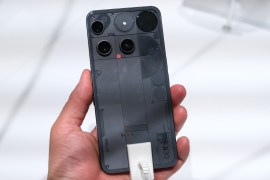Projectiondesign M20 review
Projectiondesign has fashioned a small and rather beautiful projector – but will the lack of Full HD support hold it back?
Ah, Norway. Home to, er, Norwegians. But let’s be honest: it’s not the sort of place you’d automatically associate with high-end video projectors, is it? But believe it or not, Scandinavian outfit Projectiondesign is actually one of the world’s biggest and best, and the M20 is its latest model.
Of course, competing head-on with big-name Japanese brands isn’t easy, so Projectiondesign tries its best to make its kit stand out from the crowd. To ensure a more living-room-friendly design, it always makes its projectors as small as possible – the M20 would scarcely cover a piece of A4 – and super-colourful, as shown by as the Ferrari-style Maranello Blue finish shown here.
Sensible spec
Most importantly of all, Projectiondesign refuses to get carried away by the spec war that some rivals obsess over. The M20 might be a high-end projector, but it’s still ‘only’ an HD-Ready 1280×720 design, not a Full HD 1920×1080 performer like some rivals.
It’s still well specified in many other ways: for example, it’s the only 720p projector around to have the full implementation of Texas Instruments’ BrilliantColor image processing, with a six-segment colour wheel offering the three primary colours, (red, green and blue) backed by the three ‘secondary’ colours (cyan, magenta and yellow). That gives it the potential for billions rather than millions of possible colour variations, and more colour variation means more realism.
BrilliantColor projectors also tend to be punchier than conventional rivals, because they don’t have a dark-green ‘ND’ colour filter in between their lamp and the lens, and the M20 is true to type: its contrast ratio is rated at 4000:1, and the image quality bears that out.
Set-up could be simpler
Having said all of that, there are few oddities to this projector that we could do without. Early samples came with a DVI-D connector (apparently set for replacement with an HDMI on later models), and the remote control isn’t the most intuitive in the world. The projector can also take its time about switching inputs or resolutions: it gets there eventually, but doesn’t like to be rushed.
But, once you’ve nurtured it into action, you’re sure to be impressed. This is a largely stunning performer, its colours and contrast producing thrilling pictures with both hi-def and standard-definition content. Background noise is kept well in check, and details show just the right blend of sharpness and stability. Even with noisy old broadcast TV, you’re seldom distracted by unsightly edge shimmer or motion smearing.
Full HD for best results
Of course, the best results come from feeding the M20 with Blu-ray or HD DVD signals. It readily accepts 1080p and 24fps, scaling it to suit its needs before displaying it at 48Hz, and the end results are definitely impressive.
However, it’s hard to shake the notion that you can see more detail ‘pixel-for-pixel’ with some Full HD alternatives: the M20’s detail and sharpness satisfy, but you don’t get quite the same sense of stunning, ultra-revealing resolution as you do from, say, the InFocus IN82. That costs £500 less, to boot, although in fairness it’s much bigger, and also doesn’t have the full implementation of BrilliantColor.
In the end, the M20’s style, size and quality do give it a considerable appeal. Were all things equal, we’d probably opt for the IN82 – but if you just can’t fit one of those into your life, the Projectiondesign’s ultra-small dimensions and high performance give it a unique appeal.



